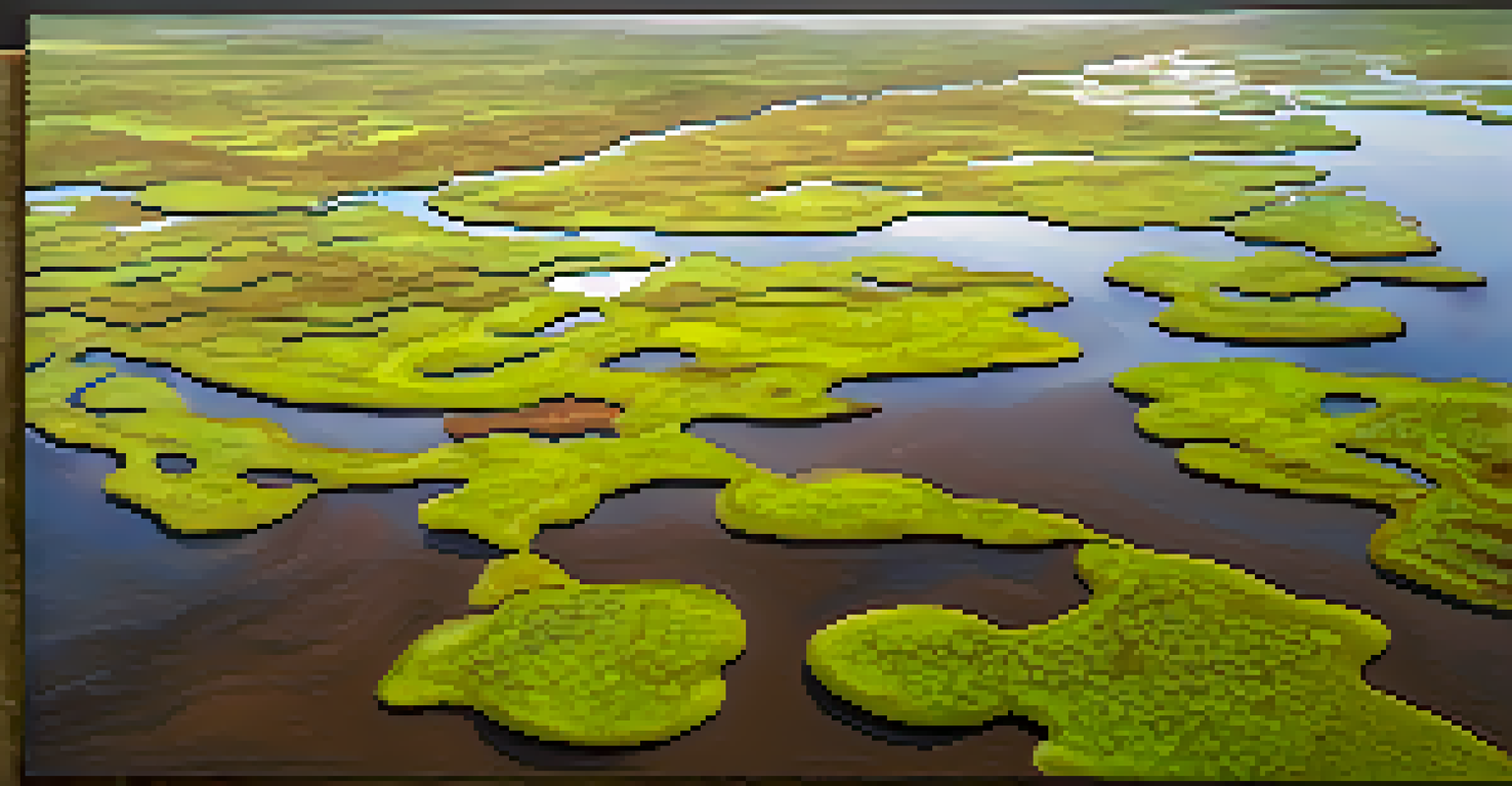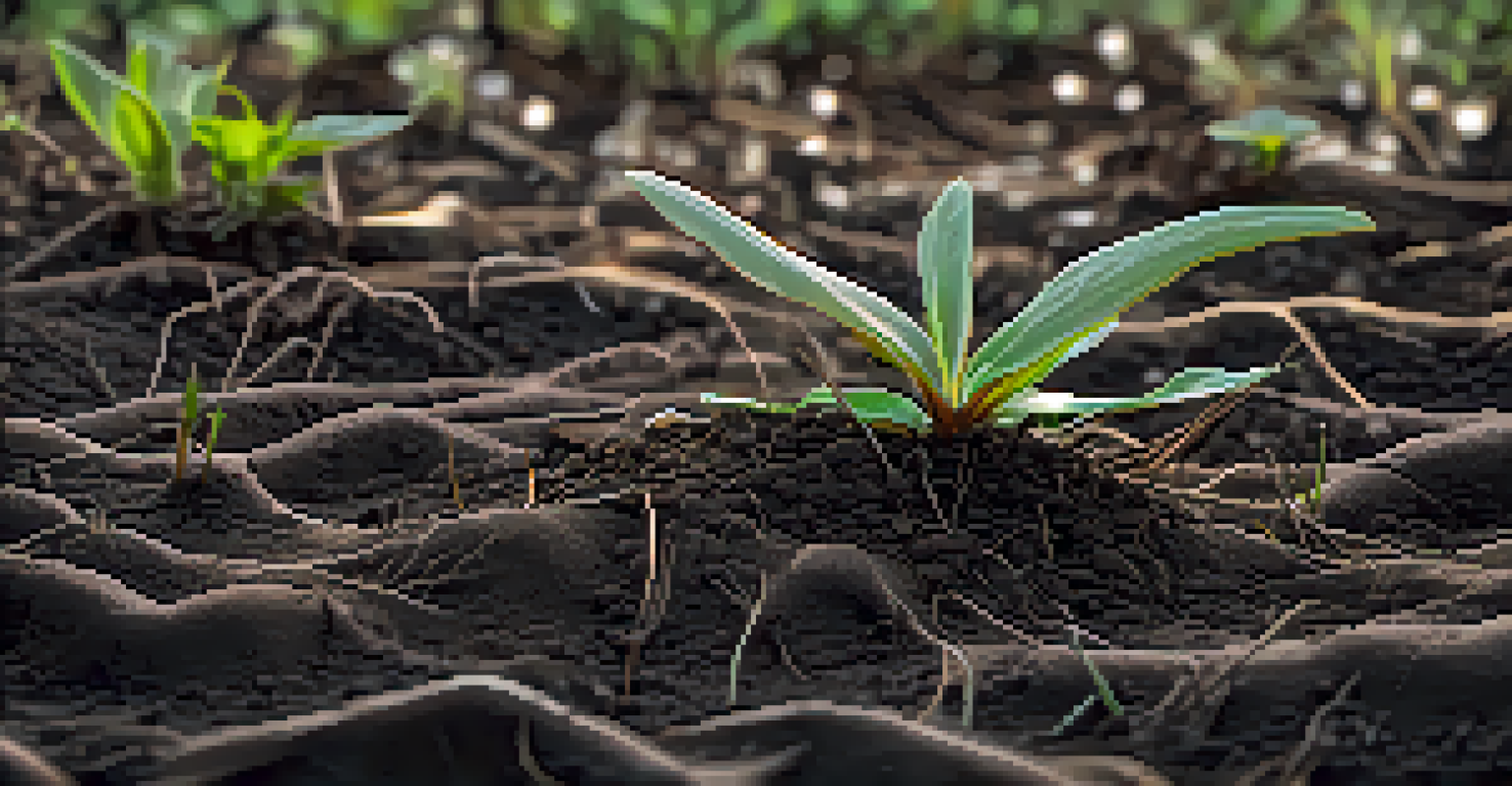The Role of Wetlands in Carbon Sequestration Explained

Understanding Carbon Sequestration in Simple Terms
Carbon sequestration is the process where carbon dioxide (CO2) is captured and stored, helping to mitigate climate change. Imagine it as nature's way of taking a deep breath and holding onto that breath, preventing excess carbon from entering the atmosphere. Wetlands play a crucial role in this process, acting like sponges that absorb and store carbon.
The best time to plant a tree was twenty years ago. The second best time is now.
These ecosystems, which include marshes, swamps, and bogs, are incredibly efficient at trapping carbon within their soil and vegetation. In fact, they can store more carbon per unit area than forests! This makes wetlands vital allies in our fight against global warming.
By understanding the basics of carbon sequestration, we can appreciate the importance of preserving wetlands. It’s not just about protecting a habitat; it’s also about safeguarding the planet’s health and regulating our climate.
How Wetlands Capture Carbon from the Atmosphere
Wetlands capture carbon primarily through the growth of plants, which take in CO2 from the atmosphere during photosynthesis. Think of these plants as nature’s carbon vacuum cleaners, removing CO2 from the air and converting it into organic matter. When these plants die, their remains decompose slowly in the waterlogged soil, which is low in oxygen, allowing carbon to be stored rather than released.

This process is critical because the anaerobic conditions (low oxygen) in wetlands slow down decomposition. As a result, carbon can accumulate over long periods, making wetlands some of the most effective carbon sinks on Earth. This is why conserving these areas is essential for maintaining our planet’s carbon balance.
Wetlands Are Key Carbon Sinks
Wetlands can store more carbon per unit area than forests, making them crucial in the fight against climate change.
In essence, wetlands are continuously working to remove carbon from the atmosphere and store it safely in their soils. By preserving these ecosystems, we can enhance their ability to sequester carbon and combat climate change.
The Unique Soil Composition of Wetlands
Wetland soils have a unique composition that plays a significant role in carbon storage. These soils, often referred to as hydric soils, are saturated with water for extended periods, which creates an environment that limits oxygen. This lack of oxygen is crucial because it slows down the decomposition of organic matter, allowing carbon to remain stored in the soil.
In nature’s economy, the currency is not money, it is life.
The accumulation of partially decayed plant material, known as peat, is common in many wetlands. Peat acts like a time capsule, locking away carbon for thousands of years. This accumulation not only contributes to carbon sequestration but also enhances the fertility of the soil, supporting diverse plant life.
Understanding the unique characteristics of wetland soils helps us realize their importance in the broader context of carbon management. Protecting these soils means protecting their ability to sequester carbon effectively.
Wetlands vs. Other Ecosystems in Carbon Storage
When comparing wetlands to other ecosystems like forests and grasslands, wetlands often outperform them in carbon storage. While forests are well-known for their ability to sequester carbon, wetlands can store it at much greater depths. This means they can hold more carbon in a smaller area, making them incredibly efficient carbon sinks.
For example, studies have shown that peatlands, a type of wetland, can store about 30% of the world’s soil carbon despite covering only 3% of the Earth's land surface. This statistic highlights the disproportionate impact wetlands have on global carbon cycles compared to their size.
Threats to Wetlands Endanger Carbon
Urban development, agriculture, and climate change threaten wetlands, risking both their carbon storage capabilities and releasing stored carbon into the atmosphere.
Recognizing the superiority of wetlands in carbon sequestration emphasizes the need for their protection. They are not just valuable ecosystems; they are essential players in the climate change battle.
Threats to Wetlands and Their Carbon Storage Ability
Despite their importance, wetlands face numerous threats that jeopardize their ability to sequester carbon. Urban development, agriculture, and climate change itself are leading to the degradation and loss of these vital ecosystems. When wetlands are drained or damaged, not only do we lose their carbon storage capabilities, but we also risk releasing stored carbon back into the atmosphere.
For instance, when peatlands dry out due to drainage, they become oxidized, releasing significant amounts of CO2. This not only negates the carbon storage benefits but can also exacerbate climate change. The dual threat of loss and release makes it imperative to protect these ecosystems.
Awareness of these threats is the first step toward conservation. By understanding what endangers wetlands, we can advocate for their protection and restoration, ensuring they continue to play their critical role in carbon sequestration.
Restoration Efforts and Their Impact on Carbon Sequestration
Wetland restoration has emerged as a powerful strategy for enhancing carbon sequestration. By rehabilitating damaged wetlands, we can revive their carbon storage capabilities and even increase them over time. Restoration efforts, such as reintroducing native vegetation and reestablishing water flow, can help restore the natural balance of these ecosystems.
For example, successful restoration projects have demonstrated that former agricultural lands can be transformed back into thriving wetlands, effectively recapturing lost carbon. These projects not only benefit the environment but also contribute to biodiversity and improve water quality.
Restoration Enhances Carbon Capture
Restoring damaged wetlands can significantly improve their carbon sequestration abilities and contribute to overall ecosystem health.
Investing in wetland restoration is not just a climate action; it’s an investment in the future health of our planet. By prioritizing these efforts, we can enhance the natural processes that sequester carbon, helping to combat climate change.
The Role of Policy in Protecting Wetlands
Effective policy is crucial in the fight to protect wetlands and their carbon sequestration potential. Governments and organizations must recognize wetlands as essential ecosystems that deserve protection and restoration. By implementing laws and regulations that safeguard these areas, we can ensure their preservation for future generations.
Policies that promote sustainable land use and development practices are essential in preventing wetland degradation. This includes initiatives that provide incentives for landowners to maintain wetlands on their properties or restore them if they’ve been damaged.

Ultimately, strong policy can create a framework that prioritizes wetland conservation and restoration. By championing these initiatives, we can enhance the role of wetlands in carbon sequestration and contribute to a healthier planet.